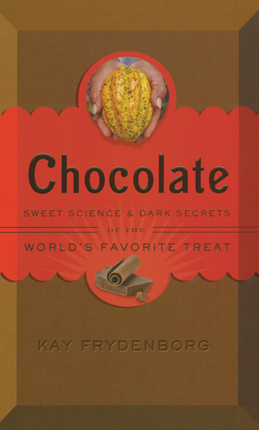Full Text Reviews: Booklist - 02/15/2015 The history of chocolate is a troubling one, riddled as it is with slavery, exploitation, and risky environmental practices, and the food itself, particularly its health benefits, is often a source of mystery. Frydenborg sets out to untangle that mystery, beginning with chocolate’s vital role in ancient Mesoamerican culture, its discovery by conquistadores, and its eventual worldwide popularity. Today, as demand for chocolate starts to outpace supply, scientists and growers are seeking out ways to adopt more sustainable cultivation practices as well as searching for wild cacao trees, which might offer clues about the plant’s origin. Covering controversy over labor laws, the chemical makeup of chocolate, and recent attempts to map the cacao genome, Frydenborg offers a wealth of information that will likely encourage students to think critically about the ecological and human cost of their favorite candies and maybe even prompt them to choose sustainable alternatives. This is a great choice for school projects or chocolate fans curious about their beloved treat. - Copyright 2015 Booklist. School Library Journal - 03/01/2015 Gr 6–8—This fascinating book presents a deep, multifaceted glimpse at a delectable dessert: chocolate. Engaging—even witty in places—and enlightening, it gives a history of the sweet treat, speculating about its little-known origins 1,500 years ago in the Upper Amazon Basin of South America, exploring its role in the European conquest of Central and South America, and discussing the dark side of chocolate: the use of slave labor to grow and harvest it. Frydenborg examines the development of chocolate as an industry in Europe and America in the 18th and 19th centuries. The book also goes into the science of the confection, such as why it's considered so tasty and its potential health benefits. Along the way, Frydenborg seamlessly weaves in information about relevant historical figures, including confectioner Milton S. Hershey; Russian scientist Nikolai Vavilov, who traced the origins of the cacao tree; and explorers such as Hernán Cortés and Francisco Pizzaro. Photographs enhance readers' understanding, though the recipes and sidebars are occasionally distracting. Robert Burleigh's celebrated Chocolate: Riches from the Rainforest (Abrams, 2002), aimed at elementary school students, is better designed, but those looking for a more detailed history for an older audience would do well to consult Frydenborg's work. VERDICT An excellent and highly original addition to history collections.—Shauntee Burns-Simpson, New York Public Library, Staten Island - Copyright 2015 Publishers Weekly, Library Journal and/or School Library Journal used with permission. Bulletin for the Center... - 07/01/2015 Modern and ancient history; botany, chemistry, ecology, and the physiology of taste; invention, commerce, and labor economics—actual samples are (sadly) the notably missing element in this multi-faceted overview of cacao, cocoa, and their marvelous manifestation, chocolate candy. Wide-ranging issues covered here resist consistent organization, though, so readers follow Frydenborg along a twisting path through the near past (e.g., the Milton Hershey generation) and the remote past (cacao cultivation predating the Maya); through the uses of cocoa as nutritious food, medicine, and sinful (literally, to some) snack; to causes of cacao’s endangerment, degradation, and hope for a brighter agri-future. Additionally, offhand references are surprisingly inaccurate. Many of her side trips are worthwhile, though—the topics of the slave trade and continuing exploitative labor practices; differences among South American, Central American, and African products; how to accommodate both taste and ethics when selecting chocolate candy. Adding to the organizational complexity, however, is the illustration layout, a hodgepodge of black and white in-text illustrations and a tipped-in section of color plates. Supplemental information nonetheless is abundant and valuable, from the chocolate timeline and bibliography to the extensive, densely annotated list of chocolate related websites. EB - Copyright 2015 The Board of Trustees of the University of Illinois. Loading...
|



